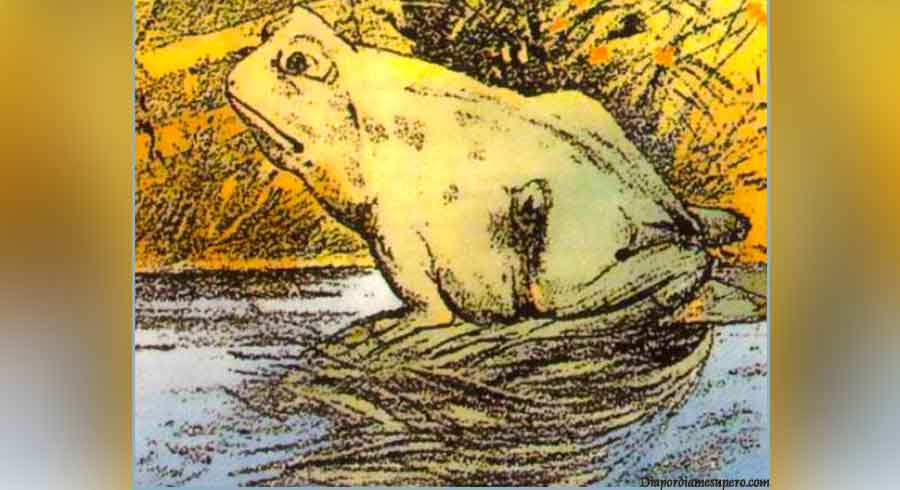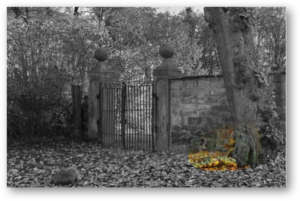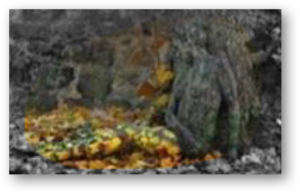by Terri Reddout
Do you see the horse in this picture? If you can’t, well, you’re dumb.

It’s a picture of a horse. Trust me. All you have to do is turn your head to the right and you’ll see it. See. See how dumb you were?
Okay, I know you’re not dumb. You just didn’t perceive the picture the same way I did. That’s the tricky thing about perception. What may be true for me, may not be true for you.
To say someone’s perception is wrong is, well, just plain wrong. Each of us perceive things differently. Our perceptions influence which truths we see. Understanding how we form our perceptions can help us better understand how we communication and how people communicate with us.
Each of us pick up on different things that create our perceptions. It’s called the perception process.
The Perception Process: 3 steps to create a perception: Select, organize, interpret. Let’s take it step by step.
Selection: The first step is selecting a stimulus
Our five sense are on the job, all the time. All. The. Time. Our senses pick up on hundreds of sights, sounds, smells, tastes and textures every minute of every day.
- Our eyes can distinguish over 7.5 million shades of color
- Our sense of smell can detect over 5000 different odors
- Our tongue can differentiate over 10,000 tastes
- Our ears can hear between 20 to 20,000 cycles per second
- Our touch can detect something as small as a 3-8 milliliter separation
Fortunately, we don’t pay attention to all this input all the time. If we did, it would drive us crazy.
Let’s put it to the test. Close your eyes. Listen. I bet you hear, taste, smell or feel something you weren’t paying attention to before. (When I do this in class I generally point out the sound of the over-head projector. Generally, people don’t hear it until I bring it to their attention.)
What causes us to pay attention to what our senses are sensing? (Other than your instructor pointing a noise out to you?) Well, it is based on repetition, intensity, or if we are in the process of changing.
- The more you hear, see, smell, taste or touch something, the more you’re going to be aware of it.
- This is why advertisers repeat commercials in multiple places multiple times. You won’t “perceive” it until you’ve been exposed to the message multiple times.
- The more times your significant other says “I’m fine. Everything is fine” the more you start to realize that things might not be “fine.”
- The intensity of the sense will also draw our attention. This can refer to how loud or startling the message is or how big an impact the message makes.
- If someone in the room yelled at you, you’d more likely pay attention than if he or she whispered the same thing.
- But if that person whispered “You just won $13 million dollars,” you’d be more likely to pay attention than if the same person whispered, “Please pass the salt.”
- When we are the process of changing we pay attention to certain stimuli. When we change something in our lives, those stimuli tend to be brought to our attention more. Like, when I recently bought my last car.
- I really wanted to replace my old Ford Explorer Sport Trac with another Ford Explorer Sport Trac.
- As I went from car lot to car lot I’d never see a Sport Trac on the lot. Yet, as I drove from one lot to the next I kept seeing Sport Tracs on the road. Sport Tracs that weren’t for sale. It drove me crazy.
- I ended up buying a Ford Edge. Now all I see on the road are Ford Edges.
- I really wanted to replace my old Ford Explorer Sport Trac with another Ford Explorer Sport Trac.
Organizing: We organize the stimuli that grabs our attention based on our experience, background, culture, age and a lot of other stuff.
Yup, that’s me holding “Ricky” raccoon. Several years ago I became an adoptive “mom” to two raccoons. My brother found them when running a backhoe on his property. They were so young their eyes were still closed. We bottle fed them for months on a mixture of kitten formula and baby rice cereal.
The raccoons used to ride around in the back of the pick-up with my brother’s two dogs. Once, Don took the dogs and the raccoons to the beach. He, his friends, the dogs and the raccoons all walked along the dunes. People stopped them along the way shouting “Are those raccoons? Can we take a picture?” Honestly, if we had a nickle for every time someone took a picture of the raccoons I’d be vacationing in the Bahamas right now.
The best story has to be when my brother filled up his truck at the gas station. An RV pulled up and a bare chested guy jumped out and walked in toward the store. Suddenly he stopped and pointed to one of the raccoon’s heads sticking out of my brother’s pick-up canopy. “Is that a raccoon?” My brother said, “Yes. And look at this.” He pulled back the canopy window and the second raccoon stuck his head out. The guy looked at Don and said “Hold on, hold on, hold on.“
He ran back to the RV and out stumbled seven other guys. My brother realized it was a mobile bachelor party when he spotted the blow-up sex doll in the RV’s back window.
They took pictures of my brother and the raccoons. Then my brother offered to take pictures of them with the raccoons. Ten minutes later they all headed back to the RV except one guy; the groom-to-be. He handed the raccoon back to my brother and said “This bachelor party has been on the road for three days and I have to tell you, these raccoons are the highlight of the entire trip.”
My perception of raccoons as fun little picture magnets wasn’t always like this. Before I became a raccoon mama this is how I organized all raccoon stimuli:
But my adoptive raccoon mom experience changed my perception of raccoons. BTW- That’s my brother, Don, in the middle. (The guy with the beard, not the bandit face!)
Interpreting: How you organize the stimuli will determine your perception
Prior to my raccoon experience I perceived raccoons as nasty little creatures. Now, whenever I see a raccoon I don’t reach out and try to pet it. I’m not nuts! But, I do smile and think about all my raccoon-related memories. My perception of raccoons has changed. And…maybe… because I provided you with a new stimuli (my raccoon mama stories) your perception of raccoons may have changed a little bit.
An example of the perception process in action
Back in my college days there was a girl in my class who I thought was too cool to want to hang out with me. What made me come to that conclusion? Well, let’s map it out.
The stimuli I picked up on
What caught my eye was Lorraine’s petite-ness. She stood about 5 foot 4 inches tall and wore one of those pixie/boy haircuts like Ann Hathaway does in this picture. She also raised her hand in class a lot. I heard she graduated from one of the big high schools in our area. And… her boyfriend always waited at the door for her after class and walked her to her car holding hands.

How I organized this stimuli
At the time I really admired petite women who could totally rock one of those pixie haircuts. Why? Probably because I was 5 foot 8 inches tall and couldn’t wear a short haircut because my head’s too big!
The fact that she raised her hand and asked really intelligent questions impressed me. It’s probably because she went to a bigger high school and had more opportunities to show off her intelligence. I went to a small high school where the ability to drive a tractor was considered impressive.
And lastly, I really wanted a boyfriend and she had one who was so attentive and romantic.
My interpretation of Lorraine
Based on how I organized the stimuli I picked up from Lorraine, I determined she was WAY TOO COOL to want to hang out with a country bumpkin like myself. While I admired her, I just knew we’d never be friends.
Then I got to know Lorraine
Same stimuli… she’s petite, rocks a pixie haircut, asks questions, from a big high school and she has a boyfriend.
Thanks to learning more about Lorraine, I discovered a new way to organize that stimuli. Lorraine told me she really envied how tall I was and how I could wear really long, wavy hair without it overwhelming me. Wow! So I’m not an Amazon! I still thought she asked intelligent questions in class, but I learned she admired the intelligent questions I asked. She did graduate from a larger high school, but I learned it didn’t have as many cool programs as I thought it did. And… her boyfriend… well it turns out he was kind of a control freak. He met her at the classroom door everyday to keep track of her. He walked her to her car and watched her drive away to make sure she didn’t interact with other people on campus.
My new interpretation… Lorraine’s cool. She thinks I’m cool. We ended up becoming roommates when we transferred to CWU (and she eventually dumped the clingy boyfriend).
Let’s put put your perception to the test
Beautiful picture, right? But can you see the woman in the picture?
Can’t see it yet? Don’t worry. Let me give you a new stimuli. You’ll find the woman sitting on the ground in the colored area of the image.
The woman sits at the base of the tree with her head turned away from us. Her right arm is bent at the elbow and resting on her lap. Her left hand sits on the ground, supporting her. Leaves cover her outstretched legs.
Here’s a closer look. See her now?
I never found the woman on my own. I organized the lack of stimuli as my inability to observe details. My interpretation was I’m a slacker when it comes to finding women in beautiful fall pictures.
Then my sister gave me new stimuli. She pointed out the woman’s head, torso, arms and legs. I reorganized that stimuli and interpreted that I’m now I’m a pretty smart cookie when it comes to finding hidden women in beautiful fall pictures. Now, whenever I see this image, the first thing I see is the woman. My perception has changed.
So what’s the lesson here?
- We need to be aware of the stimuli we put “out there” for people to organize and interpret. This includes what comes out of our mouths, our non-verbals, and the words we give people to read.
- How might people be organizing the stimuli we’re putting “out there”?
- Before jumping to a perception, analyze what stimuli you are reacting to and how are you organizing it.
- What other stimuli are you over looking that might change your perception? Are there other ways you might organize that stimuli?
- Now go to Canvas to complete the assignment.






